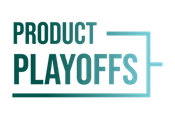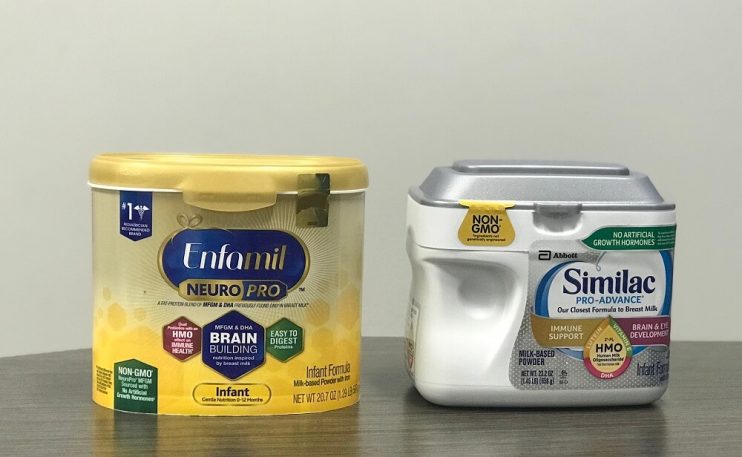Babies – they have to eat, right? It seems so simple, and easy even – but today there are so many choices when it comes to formula that it can be overwhelming to know where to start. That’s why we picked the two most popular brands of formula and decided to explore them a little more in depth. Whether you’re simply supplementing or exclusively formula feeding, we have you covered in understanding all there is to the powder you put in your baby’s belly.




Table of Contents
What is Baby Formula?
If your baby is under a year of age, they require a main source of nutrition to keep them thriving in a healthy manner. Formula is designed to mimic human milk, and though nothing can exactly replicate it, many formulas on the market have gotten quite close. Formula most commonly is a white powdery substance that is mixed with water, but there is also concentrated liquid formula and ready to use formula. Each option is great, but the cost does go up as it becomes more convenient which is why powdered formula is more frequently purchased.
Although there are different variations that compile formula such as soy, the most common component is purified cow’s milk whey as the main source of protein. It varies based on the manufacturer, but every formula also contains various minerals, vitamins, vegetable oils & carbohydrates.
Why Use Formula and For How Long?
The necessity of formula varies from family to family. A mom might be struggling to produce enough breast milk and need to supplement, another family perhaps simply did not want to breastfeed or were unable to. Formula was created to be a source of nutrients given to a baby in their first year of life, whether only partial or completely.
Technically, formula can be given to your child until age two, but it ultimately depends on the family and what works for them. Foods are introduced anywhere from 4-6 months, and formula is still incorporated during this transition. It is typical for a baby that is exclusively formula fed to switch to whole cow’s milk once they are one year old and forego formula completely. And in our experience, this is what most doctors will stand by as well. Some families prefer to slowly wean their baby off of formula and incorporate both formula and whole cow’s milk into their baby’s diet. It is best to consult your pediatrician in order to determine what will work best for your family and child’s overall health.
Why We Chose Enfamil and Similac
The specific brands we chose to explore on the topic of formula were Enfamil and Similac due to their popularity. They are widely known, and chances are good that households with children have come across samples of each in their mailbox at some point. There are many brands and products available, but these two are constantly paired against one another. We tested Enfamil’s NeuroPro against Similac’s Pro-Advance, as they are comparable formulas with similar ingredients and similar supposed effects on infants.
Enfamil is the #1 infant formula brand recommended by pediatricians and is used in more than 8 out of 10 birthing hospitals. There’s no greater reassurance for parents than a trusted source such as pediatricians and hospitals vouching for a product for your child. Although Enfamil can boast that they are backed up by accredited sources, Similac has years of experience providing a trusted product under their belt. They have been creating formula for over 90 years, and they do this without adding any artificial growth hormones – a huge selling point for parents.
Pricing
Both Enfamil and Similac are extremely comparable in price, varying only by about a dollar regardless of the quantity. Similac tends to be the one that is more expensive, but they also provide more volume per canister than Enfamil. In this product testing, a 20.7 oz tub of Enfamil NeuroPro was purchased for $27.98 while the Similac Pro-Advance was $28.98 for a 23.2 oz tub.
Even though price varies, if you look at quantity there is a reason why Similac is a little above Enfamil in pricing. You can go up to the larger canister sizes for each brand which contain 28.3oz for Enfamil and 30.8 oz for Similac. Each product also has “ready to use” formula bottles in 2 oz, 6 oz, and 32 oz. When it comes to “ready to use” formulas for the brands, Enfamil is consistently pricier than Similac.
- No.1 BRAND FOR IMMUNE SUPPORT: Similac Pro-Advance is the first infant formula with 2’- FL HMO designed to be closer than over to breast milk. (IQVIA ProVoice survey 12 months ending February 2020; not from human milk)
- NO ARTIFICIAL GROWTH HORMONES: Similac is the first leading infant formula brand with no artificial growth hormones (No significant difference has been shown between milk derived from rbST-treated and non-rbST-treated cows)
- REDUCED FUSSINESS: Parents reported reduced fussiness, gassiness, and spit-up after 1 day (After switching to Similac Pro-Advance)
Ingredients
Both have extremely similar ingredients such as nonfat milk, vegetable oil, whey protein concentrate, etc. They also have the same vitamins (A, D, E, K, and many more). The quantities of the ingredients are where they differ. For example, though Similac has a higher amount of calcium (82mg to Enfamil’s 78mg), Enfamil has more magnesium (8mg to Similac’s 6mg).
None of the amounts differ so greatly from the competitor that it makes an impact, except for one key ingredient: sugar. Similac has been found to have higher levels of added sugar whereas Enfamil does not. A huge positive in each brand’s ingredients is that neither use any GMO’s. The major difference with Enfamil NeuroPro and Similac Pro-Advance specifically is that Enfamil has more ingredients that contribute to neural and eye development. Since Similac contains added sugar their product tends to have a taste that babies enjoy more.
One study from the Journal of Nutrition shows that there are ingredients in Similac Pro-Advance that truly help boost the immune system as breast milk would. The ingredients that do this are similar to vitamin supplements and contain comparable properties. Another clinical study on Enfamil NeuroPro showed that babies who were fed formula with DHA and ARA showed improved sustained attention. The overall consensus is that Enfamil is great for brain development, and Similac has more ingredients to cater to a healthy gut and better immune system for babies.
| Enfamil NeuroPro
✔ Contains Essential Vitamins ✔ No Added Sugars ✔ Good For Brain & Eye Development ✔ Non-GMO |
Similac Pro-Advance
✔ Contains Essential Vitamins ✔ Good for Gut and Immune System ✔ Non-GMO X Contains Added Sugars |
Enfamil NeuroPro Infant Formula
- Emerging evidence from a recent clinical study showed MFGM in formula supports cognitive development similar to breast milk
- Get brain building nutrition inspired by breast milk from the formula brand that’s #1 recommended by pediatricians
- The only formula that has a fat protein blend of MFGM and DHA, previously only found in breast milk
How We Tested
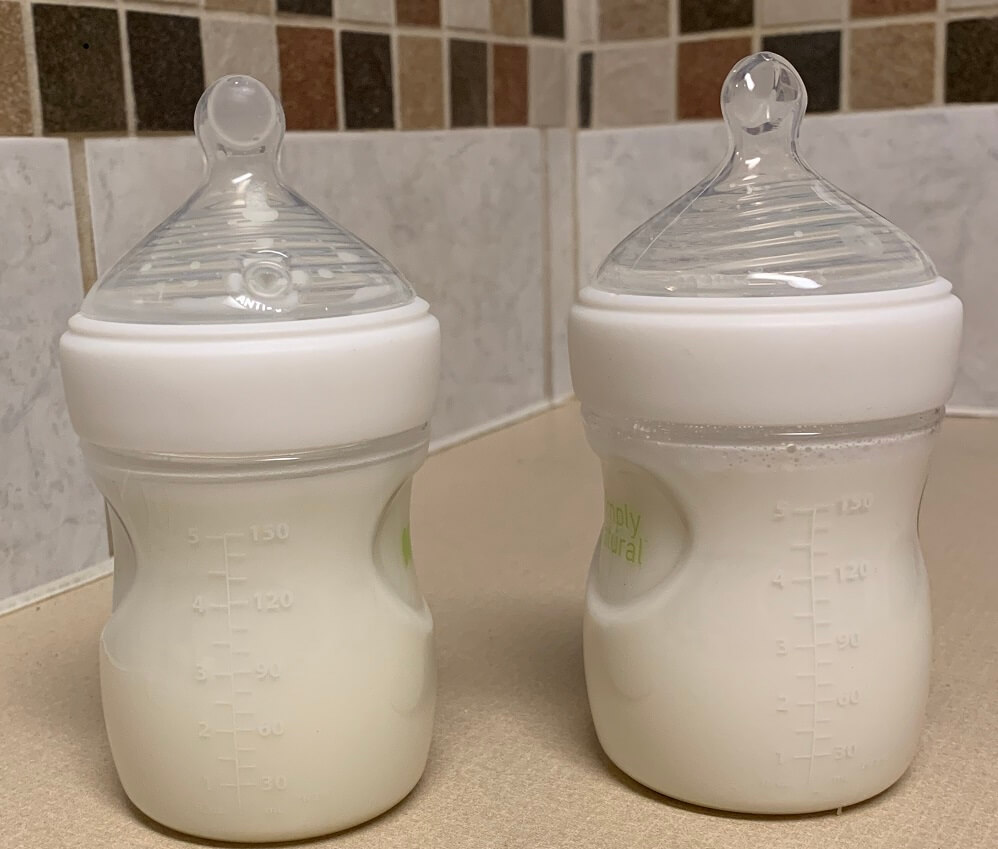

Enfamil (left) and Similac (right) mixed in our baby formula bottles.
For these two formulas, we tested using the powdered versions and mixing them with water. Each tub came with a scoop, and for every two ounces of water you put in one scoop of the powder formula and mix it in the bottle. For testing purposes, we gave the same four-month-old boy Similac Pro-Advance for one week and Enfamil NeuroPro for one week.
As far as consistency and look of the mixed formula in each bottle, they were both incredibly similar in their qualities. Though they look the same once mixed in bottles, we would have to say that Similac Pro-Advanced had a sweeter smell than Enfamil NeuroPro. It was very subtle and not noticeable unless you are looking to differentiate the two side by side. The baby did not noticeably prefer one formula over the other while drinking it, and the effects each one had on him were minimal.
Issues
We found that if you shake Enfamil in the bottle, it foams up which creates air when your baby is drinking that you don’t want, as the air contributes to gas which can also lead to fussiness. To avoid this, we recommend stirring with a spoon or gently swirling in the bottle instead of putting a lid on the bottle and shaking. The other issue we found with this brand was regardless of how it is mixed, clumps of the formula sometimes remain. It isn’t a major problem unless it finds its way to the nipple of the bottle which clogs it for the baby, but it is relatively frustrating to have powder not incorporate itself into the mix. If you’re looking for something a little more convenient, their ready to use bottles for each brand come pre-made and ready to drink which takes out any mixing/foam problems. Similac also had clumps remaining sometimes as well, which seemed to be unavoidable. Similac however, did not foam up really at all, unlike Enfamil.
Although the tester easily drank Similac Pro-Advance, he seemed to be a little fussier and gassier after each bottle than he was during the week he drank Enfamil NeuroPro. He also spit up more frequently during feedings with Similac, and although he did spit up with Enfamil too it didn’t appear to be as much.
The Best Baby Formula
Which is the best formula milk for babies?
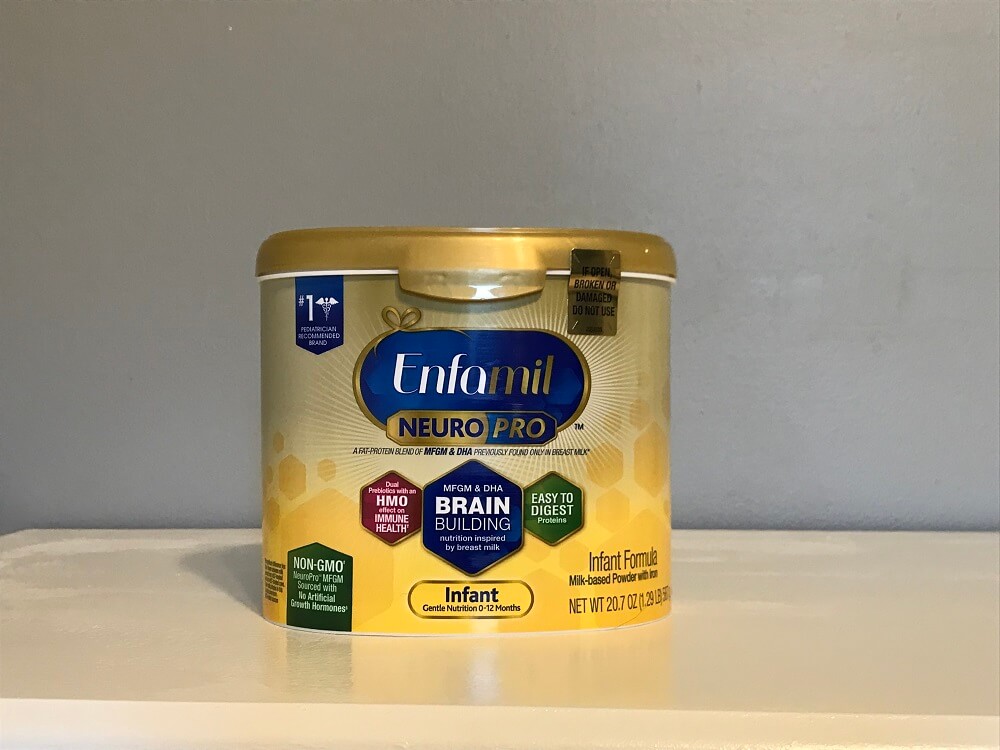

It was a close test, but our winner is Enfamil NeuroPro over Similac Pro-Advance. The baby tested better overall with Enfamil and seemed happier after each feeding with Enfamil whereas Similac left him irritable from gas. With these two specific brands the price is practically the same for their powdered products making it an easy answer to pick the one that appeases the baby most. They both have amazing benefits to your baby, but in the case of this baby he would probably need to try another product of Similac to see if that agreed with his stomach more than Pro-Advance did. Since Pro-Advance does seem to promote their product as improving gut health and immunity, their formula didn’t hold up to that for this infant. We also liked that Enfamil NeuroPro did not have any added sugars and did have multiple studies showing improved learning abilities into their later years of life.
Enfamil NeuroPro Infant Formula
- Emerging evidence from a recent clinical study showed MFGM in formula supports cognitive development similar to breast milk
- Get brain building nutrition inspired by breast milk from the formula brand that’s #1 recommended by pediatricians
- The only formula that has a fat protein blend of MFGM and DHA, previously only found in breast milk
Tips for Formula Feeding
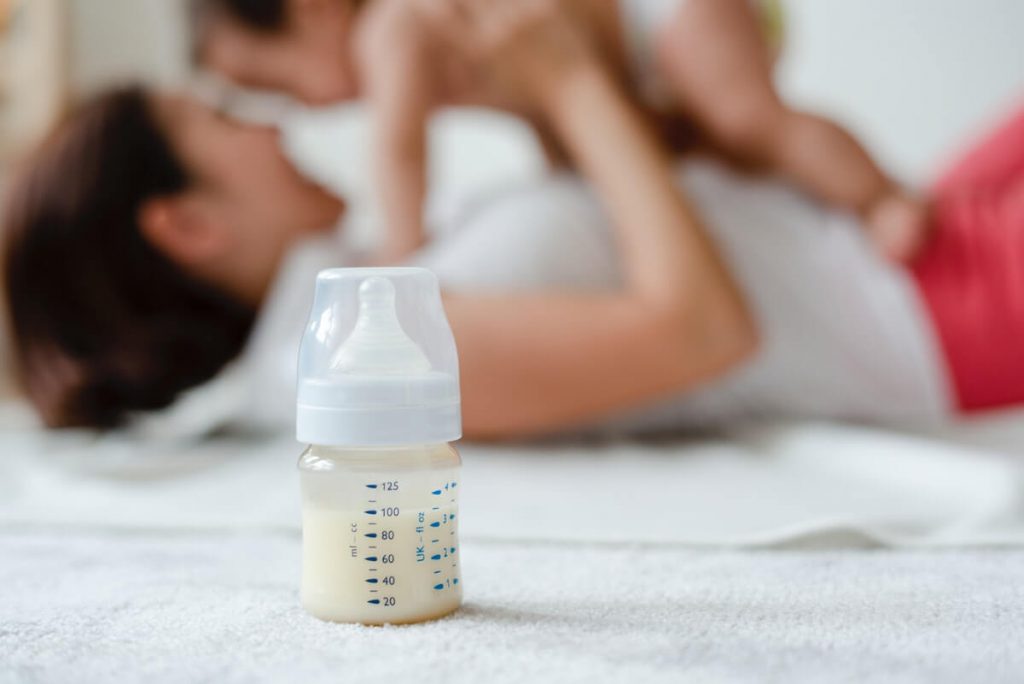

After you have gotten your hands on a tub of formula for your baby, there are a few tips that can make it a positive experience for your baby and you.
Swirl the Formula
As mentioned above, the more you shake a formula to mix the more foam and by consequence, air, you are putting into the bottle for your baby. An easy solution is to gently swirl or mix with a spoon.
Make Sure There is No Air
When feeding formula in a bottle, make sure no air is in the nipple for baby to swallow. It should always be filled with formula and not tilted at an angle.
Choose the Right Bottle
Not all bottles are created equal for babies – try several with your little one and see which one they prefer. Take into account size and nipple flow as well, so they aren’t drinking formula too fast (this leads to much more spit up).
Test On Skin
If the water is warm, test on skin to make sure it is not too hot for the baby.
Stay Away from Microwaves
Never heat up formula in a microwave!
Room Temperature Water is Okay
As long as it is not too hot, water temperature does not matter for mixing with formula. In fact, it is easier to introduce room temperature or even cold water mixed with formula, so baby does not become too accustomed to it being warm. This makes it more convenient for circumstances when you cannot heat up water.
Monitor Bowel Movements When Trying New Formulas
As long as your baby does not appear to be struggling or constipated, do not worry about how frequent they are “going” but just that the baby is comfortable.
Be Conscious of Burping
Babies frequently burp during feeding, which helps release air and sometimes helps reduce spit up.
Final Thoughts
Though Similac Pro-Advance did not ultimately win, there are other Similac products that could be explored to compare instead. Both Enfamil and Similac have products that specialize in fussiness – Similac Sensitive and Enfamil Gentlease, popular choices among parents for that reason alone. Overall, the thing to keep in mind is that every baby is extremely different and family preferences come into play. Ingredients do matter – so if not having added sugars in your baby formula is most important, Enfamil is an easy choice. Enfamil makes it clear they do not add sugar, something Similac does with all of their formulas. It ultimately is decided by what is most important for you for what your child consumes, and then by what the baby tolerates best.
Formula is a great asset and alternative to breastmilk, as both Similac and Enfamil have done extensive work to make it as similar to breastmilk as possible. You know your baby best, so pay attention to their reactions and emotions when trying different formulas. There are also alternatives to cow’s milk formula, like soy, if you believe your child may be lactose intolerant. Do not hesitate to change brands or move to another product within a brand if one isn’t working or making your baby happy and healthy.
Enfamil NeuroPro Infant Formula
- Emerging evidence from a recent clinical study showed MFGM in formula supports cognitive development similar to breast milk
- Get brain building nutrition inspired by breast milk from the formula brand that’s #1 recommended by pediatricians
- The only formula that has a fat protein blend of MFGM and DHA, previously only found in breast milk
